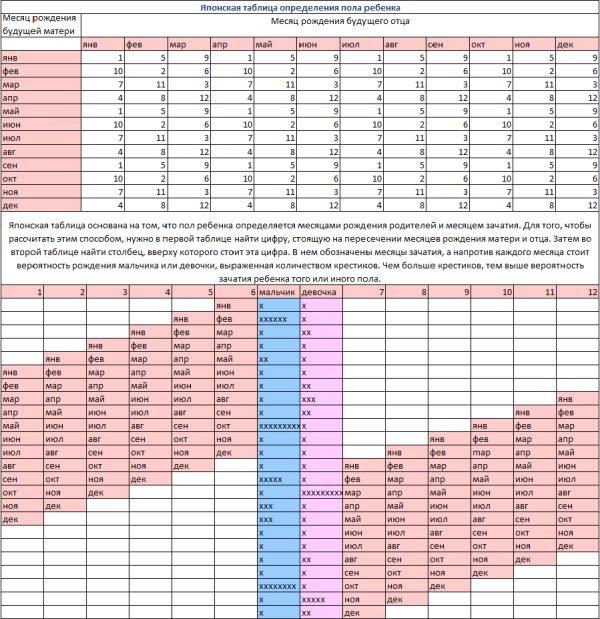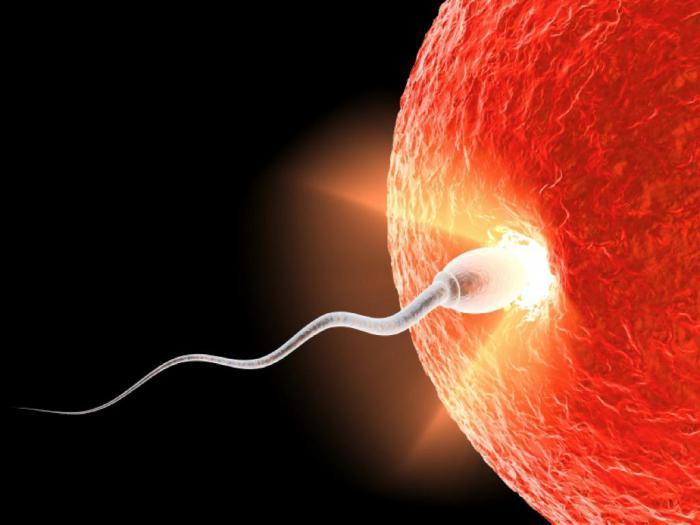Every expectant mother wants to know whether she is having a boy or a girl. Humanity has come up with many different methods. You can conduct tests and analyses, or rely on time-tested folk methods. So why should parents know the sex of their unborn baby? Maybe it’s better to just rely on the will of fate, accept its gifts and not wonder how to determine the gender of the unborn child?
Good parents want to thoroughly prepare for the arrival of another new family member. They choose clothes, diapers, and decorate the room accordingly. Will the objects surrounding the child be blue or pink?
If there are any genetic diseases in the family, the gender of the child also plays an important role. Knowing your child's possible illnesses, you can provide him with all the necessary conditions so that he grows up happy and healthy.
Almost every couple wants to find out the gender of their child.
"Chicken or the egg"?
According to an ancient beautiful legend about love, androgynous people lived on Earth, and they were a perfect race, combining both male and female traits. Heavenly forces divided androgynes into men and women. For what, is no longer so significant, but the fact remains: to this day, the halves of androgynes are looking for each other. And a man and a woman who have found their soul mate in each other become that very ideal couple, a single whole. But humanity is doomed for centuries to have offspring that are divided into men and women, born as boys and girls.
What do geneticists say?
The legend is beautiful, but the scientific approach, genetics and its subsidiary branches say something completely different. Man is perfect the way he was created, and gender difference is not a punishment for sins, but a gift from above. To live and reproduce offspring similar to oneself is the purpose of all life on Earth.
Even from the school anatomy course, we know which sex cells are responsible for conception to take place, about when the gender of the child is formed in the womb, or more precisely, when it can already be recognized. And, it would seem, at first glance, everything is extremely clear: it depends on the man what gender the child will be, but perhaps everything is not so clear after all?
Accuracy of the listed methods
On the Internet, next to different methods of determining the sex of a baby in the womb, there are often percentages in which this method supposedly works. But in different editions these probabilities are different, including chances of less than 50%, which means that the exact opposite method would work more often and would be more useful. In order not to mislead readers with unconfirmed data, since it is unclear who exactly collected these statistics, it is better not to publish them, but to turn to the opinions of experts.

You can calculate the gender of the child using different calendars and tables, but be happy with anyone who succeeds
Doctors' opinions
Elena Berezovskaya, an obstetrician-gynecologist, author of literature on women’s health, in her article on Dr. Komarovsky’s forum reminds that a 100% way without medical intervention has not yet been found, and you should consult a doctor in order to dispel your doubts:
Scientists conducted a study: don’t trust anyone. The sex of the child could only be predicted correctly 53–67% of the time. However, this is a very low indicator for predictions.
Elena Berezovskaya, obstetrician-gynecologist, author of literature on women's health.
https://lib.komarovskiy.net/malchik-ili-devochka.html
Olga Loginova, obstetrician-gynecologist, candidate of medical sciences, concludes that only a doctor, with certain manipulations, can give an accurate answer to this question:
In fact, only special tests and medical studies can help a couple determine the sex of their unborn child. These include: ultrasound examination of the fetus, amniocentesis, DNA test.
Olga Loginova, obstetrician-gynecologist, Ph.D.
https://www.emcmos.ru/articles/malchik-ili-devochka
Liya Kazaryan, obstetrician-gynecologist, candidate of medical sciences, does not advise trusting theories and calendars:
By what principle does the egg choose the “same” sperm? Why does she sometimes accept only X cells and only girls are born into the family, and sometimes only Y boys are born? Scientists cannot yet give an unambiguous answer to these questions. Therefore, it cannot be said that any diet or “calendar” method guarantees parents a boy or a girl.
Liya Kazaryan, obstetrician-gynecologist, Ph.D.
https://www.parents.ru/article/ot-chego-zavisit-pol-budushhego-rebenka/
What gender of child do you want?
To answer the question: “When is the sex of a child determined?”, it is not enough to mention only that this happens at the moment of conception. There are no forces that would influence whether a boy or a girl will be born; if conception has already occurred, it is useless to try to change this and “interfere” in the process with the help of conspiracies, talismans, prayers, etc. And in what week the sex of the child is formed is actually no longer important, because the main thing is that the baby comes to a loving family.
Of course, before conception, you should at least try to do everything possible to ensure that the desired daughter or son appears in the family, but any obstetrician-gynecologist will tell you the simple truth: “As God willing.” They do not believe in any techniques or high-tech equipment.
Ultrasound to determine the sex of the child
Determining the sex of the baby is closest to the truth, and most importantly, it is accessible to everyone - through ultrasound examination of the fetus. As a rule, it is prescribed not only for the purpose of finding out the sex of the child, but to monitor the development of pregnancy and only at a time frame, in accordance with international standards. Thus, it is recommended that the expectant mother undergo the first ultrasound at 12-13 weeks in order to identify gross anomalies in the development of the fetus at an early stage. The next study is after 20 weeks. At the same time, the baby’s organs are studied, which are already well visualized. The last ultrasound is performed when the pregnancy is full-term, and thus the volume of amniotic fluid, the weight of the baby, and the maturity of the placenta are determined.
During an ultrasound examination, the accuracy of determining the sex of the child depends on the stage of pregnancy, as well as the experience of the doctor performing it. Until the 8th week, the baby's genitals are not differentiated. Their formation in the fetus continues until approximately 12 weeks. But doctors agree that future parents can find out the sex of the child no earlier than 12 weeks of pregnancy. In boys, the scrotum and penis are visualized on ultrasound; in girls, the labia majora are visualized.
During the examination, the doctor may mistakenly determine the sex of the child: instead of the boy’s genitals, a loop of the umbilical cord or a finger is noticed, as well as swelling of the girl’s labia, which goes away over time, is very similar to the scrotum. It also happens when a boy hides his genitals behind his clenched legs, and the parents are informed that they are having a girl.
It is best to find out the sex of the baby by ultrasound at 23-25 weeks. During this period of pregnancy, the fetus is quite mobile, and most likely the doctor will be able to examine its sexual characteristics. In later stages, this can be difficult due to its low mobility and considerable size.
Many people wonder how then to accurately determine the sex of the child, even if an ultrasound can make mistakes. As mentioned above, there is only one such method - chorionic villus biopsy. It is carried out in the early stages (7-10 weeks of pregnancy) and involves drawing up a small volume of amniotic fluid with a thin needle to detect chromosomal abnormalities.
Indications for this procedure are:
- hereditary diseases associated with the X chromosome;
- identification of certain genetic conditions, establishment of twins.
This method of determining the sex of a child is not used without medical indications, but it gives an almost 100% result and allows you to calculate the sex of the child.

Medical intervention in early pregnancy in choosing the sex of the child
Theoretically, the embryo development cycle presents the same visual pattern until 11-12 weeks - it is almost impossible to distinguish a future boy from a girl. There is a very expensive way to do this at very early stages of embryo growth. But here we are not talking about the traditional method of conception, but about in vitro fertilization, when eggs grown in the mother’s body and sperm formed in the father’s body are connected outside the mother’s body by microsurgical means. And then, when analyzing the amniotic fluid of the embryo (which, in general, breaks the protective membrane of the embryo, and there is a risk of harming it, although it is small), the sex of the child is determined and a suitable embryo is implanted into the mother’s womb. In some countries, this method is practiced, and in case of an error, the pregnancy is terminated, while in others such methods are prohibited by law due to the unethical and immoral nature of aborting innocent embryos that, due to an acceptable statistical medical error, did not become children.

How to calculate the sex of a child using the pregnancy calendar?
Tables for calculating the sex of a child and so-called pregnancy calendars seem simple and accessible. You can calculate the sex of a child using the table in a matter of minutes; the main thing is to tune in to intercourse on the very day when the action plan requires it.

Planning the gender of a child is a very complex issue.
Chinese table and calculation rules
Women began to widely use the Chinese method to calculate the gender of a child from a table around the middle of the last century, when pseudo-scientific trends such as astrology and numerology became popular. The popularity of this technique can be explained by the authority of the state that gave the world Chinese sages and ancient Chinese medicine, as well as by its ease of use.
Judge for yourself, for the calculations you only need a couple of accurate data:
- date of conception (month only, not even the date);
- the age of the woman at the planned time of birth of the child.
Anyone who has ever played “battleship” or simply loved mathematics in elementary school will be able to use the table for calculating the sex of a child.
- The top line of the table is a list of months of conceiving a child from January to December.
- The left vertical is the age of the expectant mother.
- At the intersection of the horizontal line with the vertical line, a “forecast” is imprinted - in the form of the letters “M” (boy) or “D” (girl). The method couldn’t be simpler.
Any sane person understands that predicting, let alone calculating the sex of a child using a table, is the same as casting lots; the reliability is approximately the same.
Why is the method of calculating the gender of a child using a table so popular? Well, extremely dubious theories, therapies and techniques often become popular; this has always been the case - two hundred, a thousand years ago, and even in our sophisticated age.
Japanese version
There is a little more brilliance in another eastern method - Japanese, which uses the conception calendar. It is proposed to calculate the sex of the child using the “parental blood update” table.
The theory of blood renewal is deeply unscientific, since the composition of human blood is renewed much faster than the stated 3 years for women and 4 years for men.
Nevertheless, the table exists, and you can familiarize yourself with it:
- The upper horizontal column is the full age of the father at the time of conception (from 18 years old).
- The left vertical column is the mother's full age at the time of conception.
- At the intersection of the lines, as in the Chinese table, there are letters that determine the gender of the unborn baby.
Example: if the father is 30 years old and the mother is 25, then according to the table they will have a girl. How to calculate the gender of a child if they want a boy? Let's look at the table:
- a year later (when the father is 31 and the mother is 26), the table again predicts the birth of a girl;
- after 2 years - the table depicts a riddle in the form of M/D, that is, the gender of the child can be any with equal probability;
- finally, only after 3 years (when father is 33 and mother is 28) the table promises the coveted “M”.

Will you really have to wait that long? No, proponents of the idea of blood renewal explain that the results of this technique may vary depending on the month in which conception occurs. For example, the father is still 30 years old, and the mother turns 26 years old in 3 months, at this moment the table “predicts” a boy, this time can be used to conceive an heir until the father turns 31 years old. Taking into account all these nuances, it is proposed to create your own conception calendar.
Is it possible to determine in advance the sex of a child not using a table, but using a formula? Yes, the theory of blood renewal offers such an option. For example, let’s continue the calculations with an already “familiar” couple – he is 30, she is 25 years old.
- Divide the man's age by 4 (30:4=7.5).
- Divide the woman's age by 3 (25:3=8.3).
- Let's compare the results: 7.5 < 8.3.
- Whoever has the higher result “wins.”
In our case, the woman won, which means that the couple will conceive a girl when they reach the age of 30 and 25 full years. As you can see, the data coincided with the predictions of the Japanese table, but this is not surprising - the table was compiled according to such calculations.
How reliable are these methods?
You shouldn’t even think about the reliability of the methods discussed. They are no more accurate than the prediction of a tossed coin, and the possible coincidences that 50 percent of married couples can boast of are nothing more than just coincidences. Anyone who knows what influences the sex of a child, how fertilization occurs and when sex is established will never trust Eastern theories and will not look for “a table to calculate the sex of a child” (the spelling of the searchers has been preserved intentionally).
Let us remember that a person’s sex is determined during fertilization and depends on the set of chromosomes of the sperm that manages to penetrate the egg. During penetration, fertilization occurs - the fusion of female and male reproductive cells into one whole, called a zygote, which will already have 46 pairs of chromosomes that determine the sex of the conceived child.
Fertilization is possible only after ovulation, and another popular way to calculate the sex of a child is associated with the moment of its occurrence.
The most accurate answer will be given by ultrasound examination
Ultrasound examination determines when the sex of the child is formed, and quite accurately, already at 12 weeks. Of course, it happens that the ultrasound specialist makes mistakes, but the doctor’s professionalism rarely fails. True, it is impossible to recognize the sex before the 11th week (due to physiological factors) and in the last stages of pregnancy (due to the fact that the fetus is already large and there is simply not enough space to choose the right angle). Therefore, if you still want to buy a dowry for your future baby in non-neutral colors, an ultrasound will help you make your choice.
How does conception occur?
Each cell of the maternal and paternal body contains 46 chromosomes in pairs (23 pairs). Autosomes, which are represented in 22 pairs, are responsible for the genetic set transmitted from parent to child. And only a single pair - heterosomes - actually determines the sex of the future person.
Female cells do not in any way influence the formation of sex in the embryo. Her sex chromosomes are the same, they are designated by the code XX, while the male sex chromosomes have two different chromosomes in the XY chromosome pair. By connecting, two cells form variants of compounds XX or XY, that is, literally this means that one of the female chromosomes X connects with one of the male chromosomes Y or X, and the sex of the unborn child is formed when the cells merge, that is, at the moment of conception. And nothing else.

How does the process of determining the baby’s gender occur?
The whole process is not difficult. A woman's egg carries an X chromosome, while a man's egg carries an X or Y chromosome. When an egg is fertilized by a sperm containing a Y chromosome, a boy should be expected. Otherwise, a girl is born.

The sex of the child depends on the sperm, which carries either a male or female chromosome
This is a natural process, so it is very difficult to predict in advance the gender of the unborn baby or in any way influence this process.
At what week is the baby's gender determined?
Despite the fact that there are actually no sex differences in an embryo up to the 10th week (information on what period of time the child’s sex is formed physiologically is quite vague, there is data from the 10th week to the 16th week of pregnancy), this does not at all mean that the embryo before this time asexual, and he can become either a boy or a girl. If at the moment of intercourse the egg and sperm successfully meet, in one day the two cells will become a single zygote, which will split in two at the end of the first day.
Useful information on determining the sex of a child
In addition to the basic techniques that help to find out the gender of the child, the following important points can be noted:
- Spermatozoa, which are carriers of the male chromosome, unlike female ones, react poorly to negative external manifestations. For this reason, men working in hazardous work rarely give birth to boys.
- The hereditary factor also plays an important role. If the mother is from a large family with more than 4 children, then there is a high probability that she will have the predominant sex among sisters or brothers.
- Also, the sex of the child depends on the chromosome that fertilizes the cell. Sometimes the female body refuses to accept a male cell. When trying to get pregnant, some women notice that there was a delay, but pregnancy never occurred. The reason for this may also be that the female body rejected the egg fertilized by the male sperm.
- Women and men with a strong-willed character are more likely to give birth to a boy. And calm parents with a gentle character, as a rule, become parents of girls.
- Girls are born more often in families of smokers, as well as in men suffering from gout and some other diseases.
- English scientists published a study indicating that in families where the man is older than the woman, as a rule, a boy is born first. If, on the contrary, the expectant mother is older than the man, then there is a high probability that their first child will be a girl. This rule applies only to determining the gender of first-born children.
- There is an opinion that a fetal heart rate of over 140 times per minute indicates the birth of a girl; in boys, the heartbeat is rarer.
- Scientists have also found that with prolonged male abstinence before conception, more viable female sperm with the X chromosome are retained in the sperm. Males with a Y chromosome become weakened and will not be able to fertilize an egg. Therefore, after male abstinence, there is a high probability of having a girl.
Traditional methods for determining the sex of an unborn baby
Since ancient times, women have been puzzled by what gender of child they are carrying. Sometimes this was caused by curiosity and the opening of the secret veil over the main miracle - the miracle of creation. Sometimes this concerned the traditional attitude towards heirs - in countries that preach Islam, such an attitude has not been forgotten today. Therefore, at the time when the sex of the child is formed in the womb, women are already puzzled by its future.

They tried to find out the gender of future children before pregnancy (to predict it). Centuries-old practices of determining pregnancy include methods for determining the sex of an unborn baby based on a woman’s behavior, even identifying the fact of pregnancy during a period when the woman is still hiding it. They also relied on changes in her appearance, gait, pigmentation or increased swelling. Today you can often hear that a girl in the mother's womb makes the expectant mother less attractive than a boy. And this observation can be explained quite medically: after all, the girl needs the same hormones that serve her mother as a source of beauty.

It is often said that the sex of a child can be determined by the shape of the expectant mother's belly. If the pregnancy is not noticeable from the back, the neat tummy does not stand out, then a boy is expected, and if roundness is visible from the back or the sides become distinguished by softer lines and a smooth transition from chest to hip, there will be a girl. But in practice this is not at all the case, and even the same woman can look completely different during pregnancy, bearing children of the same sex.
And modern mothers, who know how to feel their children and mentally talk to them, trust their connection with the future baby and, when the sex of the child is formed in the womb, pay attention to how he is addressed - as a son or as a daughter.
Medical methods
Without bothering with calculating the sex of the child when planning a pregnancy, we will definitely return to this issue after its onset. There are several scientific methods that can predict with a certain degree of probability who will be born into the world: a little prince or a baby princess.
Ultrasonography
A safe method that most expectant parents resort to. In rare cases, an ultrasound specialist can find out the sex of the child as early as the sixteenth week of pregnancy, but more reliable results will be obtained from an examination done in the sixth month of gestation.
Unfortunately, this method has one drawback: it does not guarantee 100% accuracy. Cases when an ultrasound machine showed a girl on the monitor, but a boy was born, and vice versa, are not isolated. In the picture produced by the ultrasound, it is easy to mistake a section of the umbilical cord for one of the baby’s organs, and sometimes the fetus turns its back, as if deliberately preventing doctors and parents from satisfying their curiosity.
Chorionic villus biopsy
One of the most accurate methods with 100% effectiveness. However, its main goal is to identify chromosomal disorders in the baby, and therefore it is prescribed only to women whose tests raise suspicion of the development of genetic diseases in the fetus.
During a chorionic villus sampling, a sample of the placenta is taken. This procedure is dangerous because it can cause complications during pregnancy and cause a miscarriage.
DNA test
You can expect accurate results by performing a DNA test on the mother's blood to determine the sex of the child. What is its essence? The blood of a woman carrying a baby, starting from the sixth week, already contains elements of fetal DNA. By isolating them, geneticists can find out the gender of the baby.
The disadvantage of this method is its high cost. The cost of such a service in the clinic starts from $250.
Analysis of urine
Changes in the hormonal levels of the expectant mother are influenced by the gender of the baby. Tests sold in pharmacies react to the hormones prevailing in a woman’s body, changing their color to green (there will be a boy) or orange (there will be a girl).
The test is safe, but not highly accurate: out of 100 results, 85-90 are correct. In the case of diseases of the genitourinary system and when taking hormonal drugs, one cannot count on the accuracy of the result at all.
Fetal heart rate
A gynecologist can find out the sex of a baby by counting the number of times the unborn baby's heart beats per minute. If the heart beats 140 times or more, a girl is growing in her mother’s tummy. If the heart rate is lower, the doctor advises to wait for a boy.
This method can be used starting from the second trimester of pregnancy.
Predictions and fortune telling about who to expect in the family
Various techniques and fortune telling before pregnancy promise accurate results. And although everyone knows when the sex of a child is formed, the mystery of the most mysterious event in life attracts like a magnet. The technique of a pendulum suspended over the palm is simple: if the needle (ring, pendant) rotates in a circle, a girl will be born in the family, if it swings back and forth, a boy will be born.
Experts in palmistry say that the number of future children can be determined by the lines on the side of the hand; numerologists use numbers and an alphabetical table to determine a couple’s future child, knowing the month of its conception. But you shouldn't take predictions seriously. As they say in a popular joke, the probability of a prediction being fulfilled when the sex of a child is formed is fifty percent: either it will come true or it will not.








